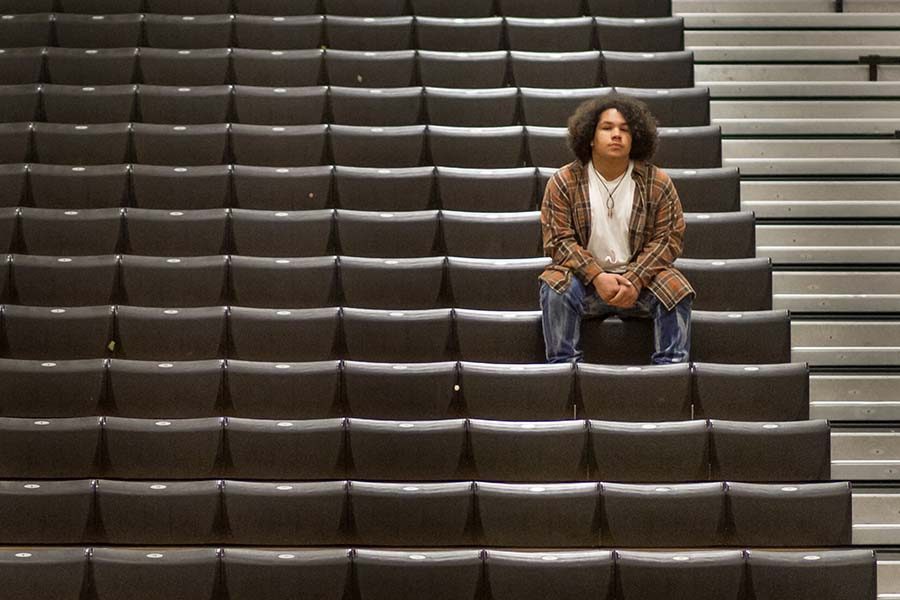Students voice concerns about mandatory pep rally attendance
Photo by Anna Kate Jordan
Keenan Thrapp sits alone on the bleachers in the Tiger Center to his feelings about mandatory pep rally attendance. Thrapp and other students that suffer from social anxiety no longer have a place to go during pep rallies.
November 2, 2017
Large double doors and a sea of rowdy students make clawing through more difficult. Finding a space to sit and feel safe is a challenge when that sea begins to swallow him. Looking around, so much is going on–peers are shouting, people are dancing, and his airways begin to shrink. Though he’s being swarmed by others, he feels more alone than ever.
Students who suffer from anxiety have issues with pep rallies. They often experience fear or pain in the loud, crowded area.
“I don’t like going to the pep rallies because it’s too chaotic for me, ” freshman Keenan Thrapp said. “I have sensitive hearing, and most times, I have to sit next to the band and it hurts my ears.”
While pep rally attendance is considered mandatory, principal Brad Bailey said there may be exemptions.
“Everybody goes to pep rallies unless there is a special circumstance,” Bailey said. “But for someone who has autism or is documented medically, we evaluate the situation. If they’re in a closed space that creates anxiety for them, then they’ll be in the library with one of our aids. I’m not aware of anything right now.”
Bailey worries that students will take advantage of an alternative setting.
“If you advertise it too much, then everybody has anxiety all of the sudden and it overshadows the ones that really have it,” Bailey said. “So we address that on a case-by-case basis. Our policy is everyone goes to pep rallies, so we don’t have students doing things they aren’t supposed to do.”
Sophomore Atlas Hines has had experiences in the pep rallies that spark his anxiety and bring on panic attacks.
“I have anxiety and loud crowded places don’t do well with me. My first time leaving [the pep rally], everyone flooded around me and I tripped and everyone kept coming down and I was stepped on,” Hines said. “Now when I go into pep rallies or if there’s a lot of people in the gym it’s a trigger for panic attacks.”
Bailey recognizes Hines’ concern, and shared what he believes to be the best solution.
“We will make a determination so we can see if they have a valid reason. I’ll make a list, and I’ll put it in the library,” Bailey said. “They would check in when they went in the library. If that person doesn’t show up, then that person would have to return to the pep rally.”
Though some students have characteristics that set them apart, they still have a desire to join the rest of their peers and show their school spirit.
“If we know there’s a situation where they still want to go to the pep rally, what we can do is locate them around the first row, closer to a door. That’s giving them a better proximity,” Bailey said.
Bailey said students can come to him to address their concerns.
“If we know in advance, then they can come up here,” Bailey said. “[Ms. Valerie Ray] is next door so that they can just put their name in a note in my tray, and I’ll call them out of class and see what’s going on and go from there.”
Thrapp understands Bailey’s solution but recognizes that other students may not feel the same way.
“Everyone reacts differently. It’s not just about me,” Thrapp said. “There are lots of students who can’t handle the pep rallies well. Students need a safe space to go instead.”

















Kathrine • Aug 19, 2019 at 1:57 pm
NO student should be required to go to pep rallies. Rallies are not part of education, they are pure public relations. Those students who couldn’t care less about sports but just want to study, learn, and go home at the end of the day should be allowed a study hall. Otherwise it’s a giant waste of their valuable school time.
I am currently trying to get my daughter out of pep rallies because the noise gives her migraines. But no student should have to get a medical excuse to not participate in this outdated, waste of time publicity stunt we call a pep rally. If a school wants kids to feel school pride, try getting their grades up and funding the arts. Then they’ll have something to be proud of, real accomplishments.